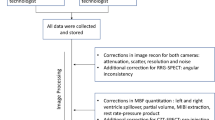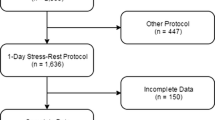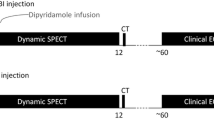Abstract
Myocardial scanning (MS) and radionuclide ventriculography (RNV) are the foundation of nuclear cardiology. These procedures aim in two completely different directions: RNV tries to image heart motion, that is, mechanical (pump) function, and therefore belongs to the group of first-order functional imaging (FI, imaging mechanical function), whereas MS is based on myocardial metabolism, and therefore can be attributed to third-order functional imaging (metabolism). This statement is relevant for the assessment of the clinical position of RNV: Third-order (metabolism) functional imaging is the domain of nuclear medicine (NM), whereas first-order FI has to face the competition of alternative noninvasive procedures such as ultrasound (US), digital subtraction angiography (DSA), computer tomography (CT), and nuclear magnetic resonance (NMR). The domain of RNV includes stages two (acute infarction) and three (postinfarction period) of coronary arterial disease (CAD). The advantageous combination of quantitative data on global, left ventricular (LV) function and imaging of regional motion ensures the superiority of RNV over US. However, RNV is inferior to MS in physical examinations in the preinfarction stage of CAD, whereas US is clearly inferior to both NM procedures. Recent progress could be attained by gated SPECT (GASPECT). A proposal is presented for simplification of this time-consuming procedure. Technetium-labeled isonitriles offer the chance for the combination of “perfusion-motion” imaging of the myocardium. However, even standard RNV offers new possibilities. The multitude of parameters produced by quantitation has not yet been exploited completely. This can be done by discriminant analysis. The computer finds out an optimal subset from the whole set of parameters for the solution of a significant clinical problem. The software “learns” to find the “label” of a special pathognomonic entity. This computer work is supported by a relational data bank (Oracle) and an optical disk. Two examples for the effectiveness of the computer in problem solving are presented. It is concluded that RNV, even in the very competitive class of first-order functional imaging, enjoys a preferred position. The future indeed seems brighter because labeled isonitriles offer the chance for the combination of perfusion-motion imaging of the myocardium.
Similar content being viewed by others
References
Adam WE (1987) A general comparison of functional imaging in nuclear medicine with other modalities. Semin Nucl Med 17:3–17
Adam WE, Bitter F (1981) Advances in heart imaging. In: IAEA (ed) Medical radionuclide imaging. IAEA, Vienna, pp 195–218
Adam WE, Stauch M (1985) Clinical and pathophysiologic aspects of testing antianginal drugs with radionuclides. In: Abshagen U (ed) Handbook of experimental pharmacology. Springer, Berlin Heidelberg, vol 76, pp 213–237
Adam WE, Schenck P, Kampmann H, Lorenz WJ, Schneider WG, Ammann W, Bilaniuk L (1969) Investigation of cardiac dynamics using scintillation camera and computer. In: IAEA (ed) Medical radioisotope scintigraphy II. IAEA, Vienna, pp 77–91
Borer JS, Bacharach SL, Green MV, Kent KM, Epstein SE, Johnston GS (1977) Real-time radionuclide cineangiography in the non-invasive evaluation of global and regional left ventricular function at rest and during exercise in patients with coronaryartery disease. N Engl J Med 296:839–844
Delaloye B, Rivier JL, Banna G (1969) Explorations circulatoires a l'aide de la camera a scintillations. In: IAEA (ed) Medical radioisotope scintigraphy. IAEA, Vienna, pp 93–107
Eilles C, Gaudron PJ, Börner B, Ertl G, Kochsiek K (1987) Korrelation regionaler Kontraktions- und Perfusionsstörungen bei Patienten mit subakutem Myokardinfarkt. Z Kardiol 76 (abstr):17
Feinendegen LE (1978) Minimal transit times. Nucl Med 17:191
Freeman AP, Giles RW, Walsch WF, Fischer R, Murray IP, Wilkken DE (1985) Regional left ventricular wall motion assessment: Comparison of two-dimensional echocardiography with contrast angiography in healed myocardial infarction. Am J Cardiol 56:8–12
Geffers H, Stauch M (1979) Assessment of regurgitation fraction by radionuclide ventriculography. Z Kardiol 68:491–496
Geffers H, Meyer G, Bitter F, Adam WE (1975) Analysis of heart function by gated blood pool investigations (Camera-Kinematography). In: Raynaud C, Todd-Pokropek A (eds) Information processing in scintigraphy. Proceedings of the fourth international conference on information processing in scintigraphy. Orsay, Commissariat à L'Energie Atomique, pp 462–465
Geffers H, Adam WE, Bitter F, Sigel H, Kampmann H (1977) Data processing and functional imaging in radionuclide ventriculography. 4th International conference on data processing and medical imaging, Nashville, Tennessee
Gill JB, Moore RH, Tamaki N, Douglas Miller D, Barlai-Kovach M, Yasuda T, Boucher CHA, Strauss HW (1986) Multigated blood-pool tomography: New method for the assessment of left ventricular function. J Nucl Med 27:1916–1924
Hör G, Maul FD, Standke R, Grossmann R, Kober G, Kaltenbach M (1985) Transluminale Koronarangioplastik: Nuklearmedizinische Ergebnisse. In: Hör G, Kaltenbach M, Maul FD, Pabst HW (eds) Interventionelle Nuklearkardiologie. Kern und Birner. Frankfurt am Main, pp 14–21
Hoffmann C, Kleine N (1965) Eihe neue Methode zur unblutigen Messung des Schlagvolumens am Menschen über viele Tage mit Hilfe von radioaktiven Isotopen. Verh Dtsch Ges Kreislaufforsch 31:93–96
Hundeshagen H (1975) Die digitale Radionuklid-Angiokardiographie. In: Pabst HW, Hör G, Schmidt HAE (eds) Nuklearmedizin: Fortschritte der Nuklearmedizin in klinischer und technologischer Sicht. FK Schattauer, Stuttgart, pp 17–26
Klepzig H Jr, Standke R, Kunkel B, Maul FD, Hör G, Kaltenbach M (1985) Nicht-invasive Bestimmung der Regurgitationsfraktion bei Patienten mit Aorteninsuffizienz. In: Hör G, Kaltenbach M, Maul FD, Pabst HW (eds) Interventionelle Nuklearkardiologie. Kern und Birner, Frankfurt am Main, pp 154–161
Kohler J, Sigel H, Delagardelle C, Schmidt A, Henze E, Adam WF, Stauch M (1985) Ventrikelfunktion beim akuten Myokardinfarkt (Left ventricular function in patients with acute myocardial infarction). In: Erbel R, Meyer J, Brennecke R (eds) Fortschritte der Echokardiographie. Springer, Heidelberg New York, pp 49–57
Kress P, Bitter F, Stauch M, Garvie N, Nechwatal W, Sigel H, Adam WE (1982) Radionuclide ventriculography: A noninvasive method for the detection and quantification of left-to-right shunts in atrial septal defect. Clin Cardiol 5:192–200
Kress P, Wiehammer S, Bitter F, Adam WE, Stauch M (1987) The role of left ventricular enddiastolic volume and regurgitant volume as determined by radionuclide ventriculography in the decision making for valve replacement in chronic aortic regurgitation. Nucl Med 26:114 (abstr)
Limacher MD, Quinones MA, Poliner LR, Nelson JG, Winters WL Jr, Waggoner AD (1983) Detection of coronary artery disease with exercise two-dimensional echocardiography. Description of a clinically applicable method and comparison with radionuclide ventriculography. Circulation 67:1211–1218
Ohtake T, Nishikawa J, Machida K, Momose T, Masuo M, Serizawa T, Yoshizumi M, Yamaoki K, Toyama H, Murata H, Iio M (1987) Evaluation of regurgitant fraction of the left ventricle by gated cardiac blood-pool scanning using SPECT. J Nucl Med 28:19–24
Osbakken MD, Boucher CA, Okada RD, Bingham JB, Strauss HW, Pohost GM (1983) Spectrum of global left ventricular responses to supine exercise. Limitation in the use of ejection fraction in identifying patients with coronary artery disease. Am J Cardiol 51:28–35
Pavel D, Byrom E, Swiryn S, Meyer-Pavel C, Rosen K (1981) Normal and abnormal electrical activation of the heart. In: IAEA (ed) Medical Radionuclide Imaging. IAEA, Vienna, pp 253–261
Ratib O, Henze E, Schön H, Schelbert HR (1982) Phase analysis of radionuclide ventriculograms for the detection of coronary artery disease. Am Heart J 104:1–12
Rigo P, Alderson PO, Robertson RM, Becker LC, Wagner HN (1979) Measurement of aortic and mitral regurgitation by gated cardiac blood pool scans. Circulation 60:306–312
Rigo P, Larock MP, Cantineau R (1987) Evaluation of the extent of coronary artery disease with Tc-99m MIBI, a new myocardial perfusion agent. J Nucl Med 28:655
Rozanski A, Diamond GA, Berman D, Forrester JS, Morris D, Swan HJC (1983) The declining specificity of exercise radionuclide ventriculography. N Engl J Med 309:518–522
Scheer KE, Jahns E, Kazem I, Gelinsky P (1967) Klinische Untersuchungen mit der Szintillationskamera mit 99m-Tc. In: Fellinger E, Höfer R (eds) Radioaktive Isotope in Klinik und Forschung. Urban & Schwarzenberg, München-Berlin-Wien, p 103
Stadius ML, Williams DL, Harp G (1985) Left ventricular volume determination using single-photon emission computed tomography. Am J Cardiol 55:1185–1191
Standke R, Hör G, Maul FD (1983) Fully automated sectorial equilibrium radionuclide ventriculography. Proposal of a method for routine use: exercise and follow-up. Eur J Nucl Med 8:77
Standke R, Maul FD, Hör G (1985) Vollautomatische Äquilibrium-Radionuklidventrikulographie: Sektorale Ejektionsfraktion und Phasenanalyse. In: Hör G, Kaltenbach M, Maul FD, Pabst HW (eds) Interventionelle Nuklearkardiologie. Kern and Birner, Trankfurt am Main, pp 220–231
Stauch M, Kress P, Geffers H, Nechwatal W, Bitter F, Sigel H, Adam WE (1981) Influence of isosorbide dinitrate and mononitrate on the ejection fraction and wall motion parameters at rest and under exercise in patients with coronary heart disease. In: Lichtlen PR (ed) Nitrates III. Springer, Berlin Heidelberg New York
Strauss HW, Zaret BL, Hurley PJ, Natarajan TK, Pitt B (1971) A scintiphotographic method for measuring left ventricular ejection fraction in man without cardiac catheterization. Am J Cardiol 28:575–580
Taylor GJ, Humphries JO, Mellits ED (1980) Predictors of clinical course, coronary anatomy and left ventricular function after recovery from acute myocardial infarction. Circulation 62:960–970
Visser CA, van der Wieken RL, Kan G, Lie KI, Busemann-Sokele E, Meltzer RS, Durrer D (1983) Comparison of two-dimensonal echocardiography with radionuclide angiography during dynamic exercise for the detection of coronary artery disease. Am Heart J 106:528–534
Wanjura CM (1985) Die Erfassung und Lokalisation linksventrikulärer Herzbewegungsstörungen mit der Radionuklidventrikulographie (RNV) im Vergleich zur Kontrastlaevangiographie (KLG). (Diagnosis and localization of regional wall motion abnormalities by radionuclide angiography and contrast angiography.) Dissertation, University of Ulm
Watson DD, Smith WH, Stubbs JB, Teates CD, Beller GA (1987) Detection of endocardial motion and myocardial thickening with gated perfusion imaging. J Nucl Med 28:618
Weismüller P, Henze E, Adam WE, Roth J, Bitter F, Stauch M (1986) Parametric imaging of experimentally simulated Wolff-Parkinson-White syndrome conduction abnormalities in dogs: A concise communication. Am J Physiolog Imaging 1:208–213
Wieshammer S, Delagardelle Ch, Sigel HA, Henze E, Kress P, Bitter F, Lippert R, Seibold H, Adam WE, Stauch M (1985) Limitations of radionuclide ventriculography in the noninvasive diagnosis of coronary artery disease. A correlation with right heart haemodynamic values during exercise. Br Heart J 53:603–610
Author information
Authors and Affiliations
Additional information
Dedicated to Prof. Heinz Hundeshagen on the occasion of his 60th birthday
Rights and permissions
About this article
Cite this article
Adam, W.E., Clausen, M., Hellwig, D. et al. Radionuclide ventriculography (equilibrium gated blood pool scanning) —its present clinical position and recent development. Eur J Nucl Med 13, 637–647 (1988). https://doi.org/10.1007/BF00256391
Issue Date:
DOI: https://doi.org/10.1007/BF00256391




